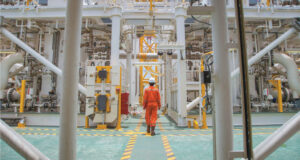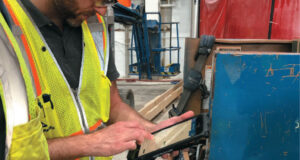JAN BOTTIGLIERI
“The process of designing, building, and starting up a paper mill is not for the faint of heart.”
If the Project Wolfpack team needed to sum up its story in one sentence, they might choose these words from Green Bay Packaging (GBP) VP-Mill Operations Matt Szymanski, delivered at the June ribbon-cutting of GBP’s new facility. The US$500+ million investment represents more than four years of planning, labor, and cooperation between company leadership, major vendors, and the state of Wisconsin, together with its energy efficiency program, Focus on Energy.
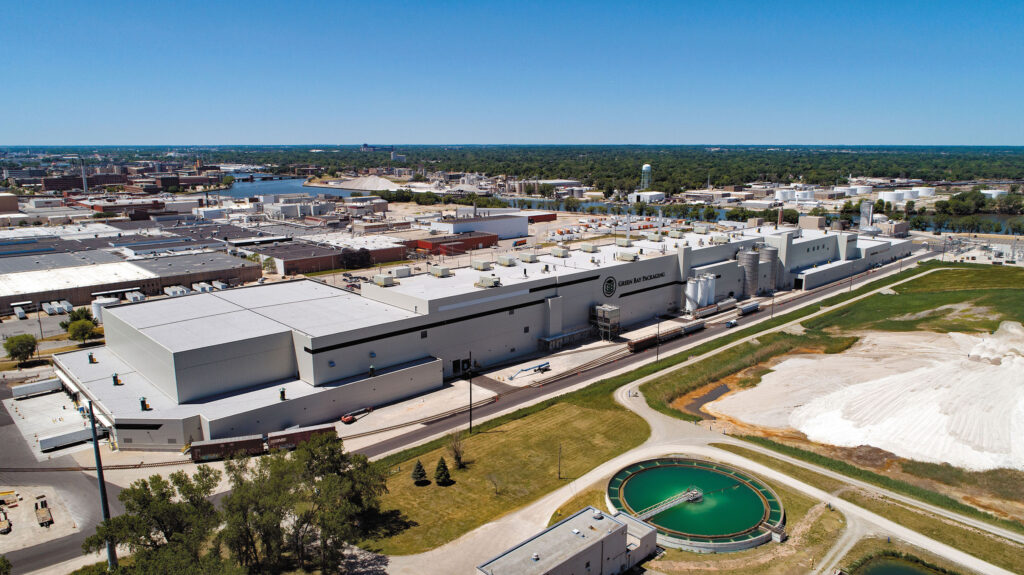
The result? The project will preserve more than 1,100 jobs across Brown County—and, in Szymanski’s words, “we have an environmentally sustainable papermaking facility that rivals any in the world. I’m not being hyperbolic when I say we are making a truly world-class sheet of paper.”
A BUSINESS CASE FOR THE FUTURE
The original mill in Green Bay was built in 1948 by George Kress, grandfather of current GBP Chairman and CEO Will Kress. It was the first paper mill in the world to use the semi-chemical pulping process; George named the machine the “Marguerite K” after his wife. That family connection lent gravity to the company’s 2017 decision to replace the mill.
As GBP’s Senior Vice President Bryan Hollenbach tells it, a 2017 brainstorming session for company leadership sparked the idea. Though the older facility had been well-maintained, they knew its remaining life was limited—and so were market opportunities without an update. Yet Hollenbach reports he wasn’t worried. “We knew that if we presented a business case for the future, the Kress family and the board of directors were so invested in this business that they would support it. We also knew we had great employees who would do whatever they could to make it happen, plus a great customer base.
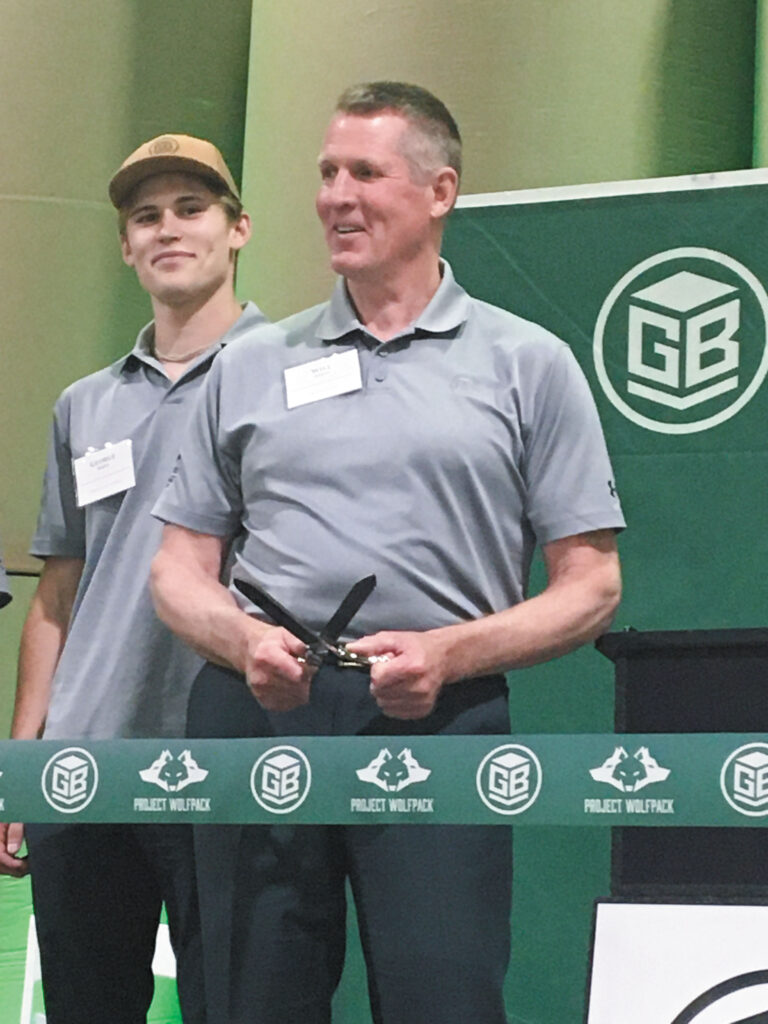
“Here’s what we didn’t know at that time: We didn’t know about COVID. We didn’t know about the quality of Miron Construction or KSH Engineering. We didn’t know how deeply Voith would partner with us. And we didn’t know about the support we’d get from the City of Green Bay, Brown County, and the State of Wisconsin,” Hollenbach says. “Because that team came together, and stuck together, we realized a great accomplishment.”
GBP leaders also decided to build the new mill at the existing Green Bay site—while still operating the current mill. At the ribbon-cutting, Will Kress admitted it was a challenge. He credits the mill’s hourly workers. “They’ve gone above and beyond the call of duty. We opened this mill in the tightest paper market we’ve ever seen in this industry, so we didn’t want any hiccups in supply. They’ve been doing double duty, because we’ve been running the old mill and the new mill at the same time since March.”
With that “business case for the future” in mind, the mill’s equipment was designed to allow flexibility between mixed paper and OCC furnish, says Bob Mihalski, director of continuous improvement—Mill Operations Group for GBP.
The original mill was designed to feed corrugator sizes in use at that time. Most modern corrugators range in size from 98” up to 132”, so the original 164” machine did not trim very well, Mihalski notes. A lot of thought went into determining the correct size for the new machine to maximize trim efficiency. “We need to be versatile for today’s corrugator sizes, while still creating flexibility to supply increasing sizes of future corrugators,” he says.
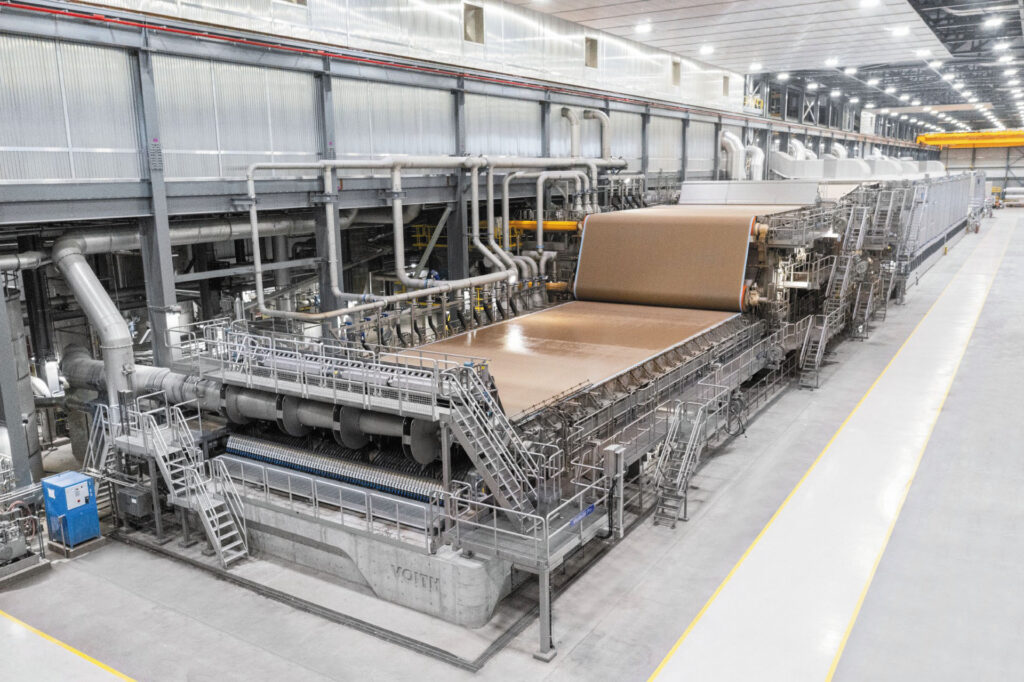
Plus, the older machine’s capacity had not kept up with the company’s growth. “The new paper machine (PM) and supporting equipment allow us to increase capacity 2.5 times from that of the original mill. This ensures a steady supply to our own converting plants, for the surge in demand post-pandemic, and for future growth,” says Mihalski.
The company also established long-term contracts with fiber suppliers and finished goods transportation companies to ensure reliable, consistent inbound and outbound logistics. “Now that we are beyond the start-up phase, we are working to implement Industry 4.0/machine learning technology,” he adds. “We are in the infancy stages of developing predictive analytics using ‘big data technology’ with the vision of moving toward prescriptive and ultimately autonomous papermaking.”
TEAMWORK MAKES THE DREAM WORK
GBP chose Voith as the project’s full-line supplier, with a massive scope of supply including a BlueLine stock preparation system; an XcelLine packaging paper machine; an AquaLine Flex water management system; VariFlex Performance winder and reject handling system; multi-year roll and clothing service agreement; plus MCS, DCS, and QCS automation solutions. Johannes (Jack) Rimpf served as Voith’s project manager through the entire project—which meant moving with his wife from Germany to Appleton, WI, for three years.
“We had an intense and very good cooperation with all the partners,” says Rimpf. “To ensure deep and effective communication from the start, we promised the customer an immediate transition of the project manager from Heidenheim to our subsidiary in Appleton (only 30 miles from Green Bay). This proximity made it possible to participate in person at all meetings from the beginning, prior to the COVID-19 pandemic.”
Voith’s OnPerformance.Lab supports the system. “Experts around the world can provide immediate technical and technological support when needed,” Rimpf says. “The quality of paper produced on this new machine is already now exceeding the current needs. Soon, with the introduction of mixed recovered paper into the stock preparation, (GBP) is set for future recovered paper compositions.”
Another key partner was Wisconsin-based design/build contractor Miron Construction Inc. “Everyone knew that the project would face challenges, but by all teams collaborating and trusting each other, it made resolving the serious challenges much easier,” says Guy Kiser, Miron project manager. “All the teams learned the importance of setting aside agendas and prerogatives to do what was in the best interest of the project, even if it is not in the best interest of your company.”
Global consulting, engineering, and EPCM services company KSH Solutions Inc. was the engineering partner for construction, providing detailed engineering, procurement, and field engineering services to Miron. KSH helped define and refine the process, notes Szymanski—“and let me tell you, this is a very unique, well thought-out process that will give us a competitive advantage.”
The mill also brought in about a dozen employees from GBP’s Morrilton, AR, plant. Many of those workers spent weeks or months away from their families. “We leveraged their strengths and expertise throughout the entire project. It not only pulled us together as a team, but allowed them to take away some learnings from the project as well,” Mihalski explains. “This will enable us to drive Operations Excellence exchanges to continue to grow together.”
Mid-construction, the coronavirus pandemic struck—but that intense teamwork ensured that the project stayed on track. Most of the equipment was already en route, which let GBP focus on keeping employees safe while operating the existing mill. “Another huge hurdle was getting start-up resources here from overseas,” says Mihalski. “It took governmental assistance to help us get the start-up support we needed. In the end, we still hit our target start-up schedule.”
Adds Rimpf, “The biggest factor in the success of the project was the outstanding motivation of every team member and the close working relationship with Green Bay. As a result, despite the challenges, all experts, who came mainly from Germany and Brazil, were able to be on site, on time, to verify installation and commissioning, adhering to all safety measures and coronavirus rules.”
When lead times and schedules could not be adjusted, Miron worked with providers to minimize the impact on the project, says Kiser. They also separated contractor break areas, amped up the cleaning schedule, and increased sanitation stations. “When the pandemic hit, the project was in full swing,” he adds. “We immediately suspended any unnecessary individuals that were not required to be onsite, including management staff. The project leadership team was split up and would attend separate meetings so that if one member of the leadership team was exposed to a positive COVID-19 case, it would not quarantine the entire leadership group.”
‘BIG TRUST’
With a few suppliers handling a major portion of the work, transparency was key. All design, construction, start-up, and commissioning activities fell under Miron’s direction and contractual obligations. To meet demands, Miron developed a crew of workers with a solid pulp and paper background, supplemented with construction professionals with strong communication skills and a desire to learn about the pulp and paper industry.
“We self-performed with our own construction crews all the structural concrete, steel erection, masonry, general trades, and equipment installation,” Kiser explains. “From November 2020 to February 2021, the site averaged more than 850 craftspeople onsite per day. Our team’s priorities were the site safety of all the workers onsite, the site logistics to construct the new facility while keeping the existing facility in operation, and the transparent communication between Miron and GBP.”
As sole machinery supplier, Voith’s project team consisted of about 70, with up to 50 supervisors on site, Rimpf says. “GBP had big trust in Voith from the beginning. The order was the first US order for a complete paper production line to be awarded to a single company. Even though this is a fully integrated plant, it is tailored precisely to the requirements of Green Bay Packaging. The parts were engineered and supplied from all over the world, with contributions from Germany and Europe, Brazil, China, and the US.
“Our highest target is always the health and well-being of personnel, and therefore we aim for zero accidents. This was achieved on Voith’s side for the entire duration of the project,” he adds. “The four pillars for project management describe Voith’s priorities quite well: Safety, Quality, Time Schedule and Budget. We established order execution processes to focus on these pillars throughout the project. Operative team meetings, core team meetings, budget and contract review meetings are just a few examples. Regular design and process review and freezing meetings helped secure the precise supply according to customer needs. This partnership started well before the contract award, but will not end after start-up.”
SAFE AND SUSTAINABLE
Mihalski has no trouble pinpointing Project Wolfpack’s two biggest gains for GBP. “First and foremost is safety,” he says. “With a high level of automation, our operators do not interact directly with equipment as they did in the old mill. Guarding, light curtains, and engineering design were meticulously taken into consideration with the design of the new mill to mitigate safety hazards.
“Also, environmental sustainability has always been key to the GBP culture. This, like safety, was factored into the design. The new mill is using a 100 percent circular reclaimed water system that prevents any discharge of process water to the Fox River. We partnered with the local publicly-owned treatment works, NEW Water, to take our pretreated water. In return, we take a side stream of water from their discharge to the river as our primary incoming water source. This is a very unique water system that minimizes any environmental impact from our water while providing benefits to the entire Fox River watershed.”
The mill’s sustainability story doesn’t stop there. Other project features include:
• Using biogas generated from the mill’s effluent treatment plant;
• Shutdown of the coal fired boilers and a switch to super-efficient natural gas boilers;
• A glycol heat recovery system that captures heat from the dryer hood to preheat the air make up to the plant;
• Using vacuum blowers instead of traditional liquid ring vacuum pumps, for energy savings;
• Using a chiller and dry cooler for year-round conditioning of operator control rooms, electrical distribution, and process control centers—“The dry coolers take advantage of seasonal temperatures and are much more energy efficient than conventional chillers,” Mihalski says;
• Installing high efficiency screens, agitators, and lighting high efficiency economizer to preheat the cold water being pumped to the boiler drums;
• Partnering with Focus on Energy to build a world-class energy efficient mill complex.
The partnership with Focus on Energy went hand-in-hand with assistance from state and local governments. This cooperation assured the mill’s sustainability performance and was critical to project completion (see sidebar on page 42.) Chairperson Rebecca Cameron Valcq, Public Service Commission of Wisconsin, explains.
“I am very excited that our Focus on Energy program played a pivotal role in building one of the most energy-efficient paper mills in the world at Green Bay Packaging. This effort resulted in significant electricity and natural gas savings—equivalent to the energy needed to power more than 10,000 Wisconsin households,” she says. “In addition, instead of flaring biogas like many landfills do, GBP beneficially utilizes biogas in its process boilers to reduce natural gas consumption—a commendable strategic approach.”
WORDS OF ADVICE
With the mill now up and running, the lessons learned can only make Green Bay Packaging stronger, says Mihalski. “Like with any project, there are things we wish we would have done differently. Organization, communication, and documentation are key efforts to capture lessons learned to be used for any other future expansions of our business.”
As an integral part of the team since that first 2017 brainstorming meeting, Bryan Hollenbach was a sounding board for project leadership from conception through start-up. “At the groundbreaking in September of 2018, I remember saying that it was an exciting day—but I also mentioned that our team was going to face some challenging times, some frustrating times. We’ll face anger, we’ll face intensity, and we’re going to have some fun. The key will be to keep this team together.”
“We faced all of that, plus,” he says. “But the team did stick together, and now we’ve got a great result.”
 Paper 360
Paper 360
